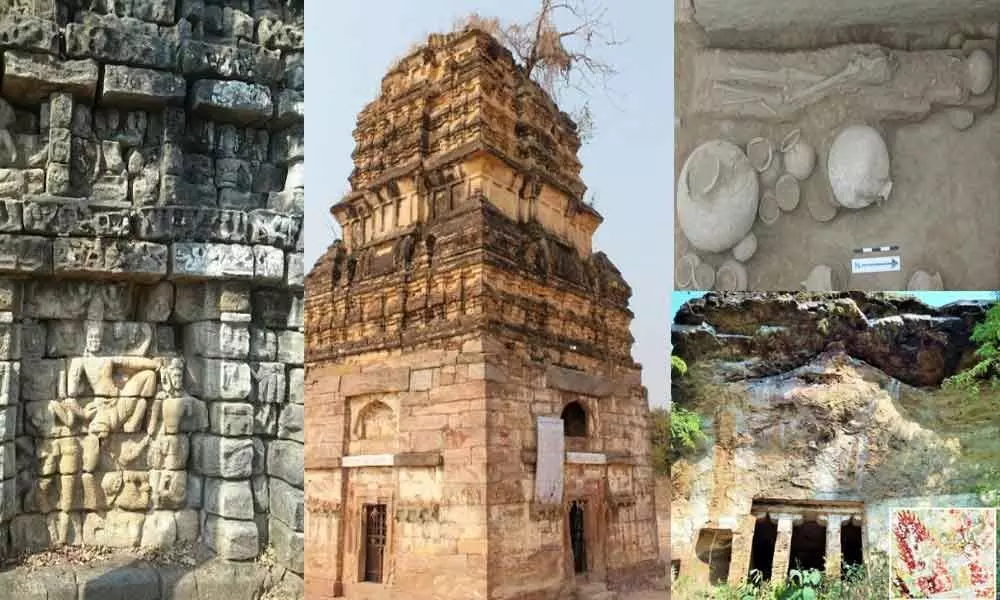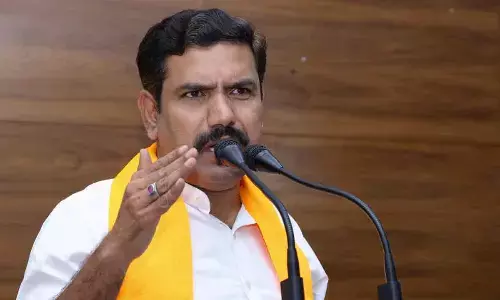Warangal, a researcher's paradise, still remains uncharted

Warangal may be proud of its historical and architecturally significant places, but there are some corners still remain uncharted.
Warangal: Warangal may be proud of its historical and architecturally significant places, but there are some corners still remain uncharted. Beyond Kakatiya dynasty that lasted about three centuries leaving an indelible impression of culture and tradition, there are quite a few sites that have historical significance all over Warangal (combined) district that date back to pre and protohistoric times.
It's said that there are no less 100 historically significant places that are yet to be explored. From Devuni gutta temple that resembles world-famous Angkor Wat structures of Cambodia to the remnants of nearly 3,000-year-old settlement found near Gajagirigutta in Bachhannapet Mandal, Warangal is a treasure trove for the history buffs to quench their thirst for research.
Travesty is such that but for the local history enthusiasts and organisations, never did the archaeological department focus on those unexplored sites which provide insights into human origins. Take the case of sandstone sculptures of Devuni gutta temple which came to limelight some three years ago is yet to get the attention of the archaeological department. Prior to that, it was only known to the Adivasis. The temple is located in the thickets near Kothur village under Mulugu Mandal.
Thanks to the local history buffs because of whose endeavours the hidden marvel caught the attention of the people. The architecture of the temple gives an impression that it refers to the times of Vishnukundina, the imperial that controlled Deccan, Odisha and parts of southern India during the 5th and 6th centuries. The sculptural elegance of the temple corresponds to that of Udayagiri and Scandagiri of Odisha, and Amaravati in Andhra Pradesh. One of the carvings inside the sanctum sanctorum has the sculpture of Tathagata.
Among those who fell to the beauty of this magnificent temple were Phillip B. Wagoner, the Professor of Art History in Wesleyan University in US, Dr Corinna Wessels-Mevissen, a German whose expertises extend to iconology of Indian sculptures and mediaeval temple architecture, and Adam Hardy, Professor of Architectural Historian at the Welsh School of Architecture, Cardiff University.
Dr Corinna had been on an observation tour to the temple twice. During her visit in December 2019, Dr Corinna observed that the temple is unique and she had never seen such a beautiful structure before. "Although there is a structural similarity between Devuni gutta temple and Angkor Wat, the former was built much earlier than the latter," Dr Corinna said, revealing her plans to write a book on this neglected temple.
"Devuni gutta is one of those extraordinary temples India has. Based on style of the architecture, the temple belongs to 6th century. It's high time the Archaeological Department take necessary steps to protect the temple which is beginning to cave in," Andy Hardy said.
Aravind Arya Pakide, who authored 'Manaku Teliyani Telangana – Tales of the Forgotten Past', said: "There are several sites in Warangal that are unique in structural elegance. But unfortunately, none of them were unravelled and explored." He said that the rock-cut cave temple near Adavi Somanapally, Nainpak temple, a perfect example of Sarvathobhadra architecture, located in Chityal mandal of Bhupalpally district, Pratapagiri hill fort nestled in the impenetrable jungle, Dameravai Megalithic burials etc are some of the examples of forgotten history.
Referring to a cluster of rock-cut cave temples, locally known as Nainagullu, located on the banks of Manair River in Koyyuru forest, near Adavi Somanapally, 22 kilometers from Bhupalpally, Aravind said that the murals painted in the caves will be lost forever. Unmindful of the historical significance, the locals whitewashed the caves and it needs to be removed using chemical treatment, he said, stating that it's high time for the authorities to protect the caves from human intervention.
According to eminent historian Jaishetty Ramanaiah, these rare cave structures believed to be of 7th or 8th Century are said to be a manifestation of sculptural elegance flourished in ancient India. "The ruined sculptures of Shivalingas, Ganapathi and Mahishasuramardhini in the caves are either idolised by Kalamukhus or Pashupathus," said noted epigraphist and Kotha Telangana Charitra Brundam (KTCB) member, S Ramoju Haragopal.
A University of Hyderabad (UoH) team led by Prof. K P Rao, conducted excavations near Gajagirigutta, locally known as Rakasipatnam, in Bachhannapet Mandal in 2018. The team collected skeletal remains of wild animals, pottery, iron objects, seashells, a copper ring etc. during the excavation. During the excavation, Eleanor Kingwell-Banham, a research associate in the eight-decade-old UCL Institute of Archaeology, one of the largest centres for archaeology, cultural heritage and museum studies in Britain, had also collected micro-botanical remains such as pollen, phytolith, charred grains etc. to find out agricultural practices and the dietary habits during the proto-historic period.
Rao said: "There is a lot of scope for the historians and archaeologists to ponder on. Especially, Warangal has a lot of scope for the research." Meanwhile, it's learnt that UoH in collaboration with the Cambridge University to conduct excavations and research in the region of Warangal, Mahabubabad and Khammam.
Kusuma Surya Kiran, a tourism promotion officer who also runs Seva Tourism and Cultural Society (STCS), a NGO aimed at popularising the art, culture, heritage and archaeology of the region, observed that archaeological findings and research give impetus to historical sites, thereby triggering tourism activity. "For many countries tourism is a major part of their economy and a significant source of income and employment. Warangal has a lot of potential to draw tourists if the authorities explore and develop some historical places that are lying in wilderness. It could be a huge boost for tourism economy in Warangal."
















